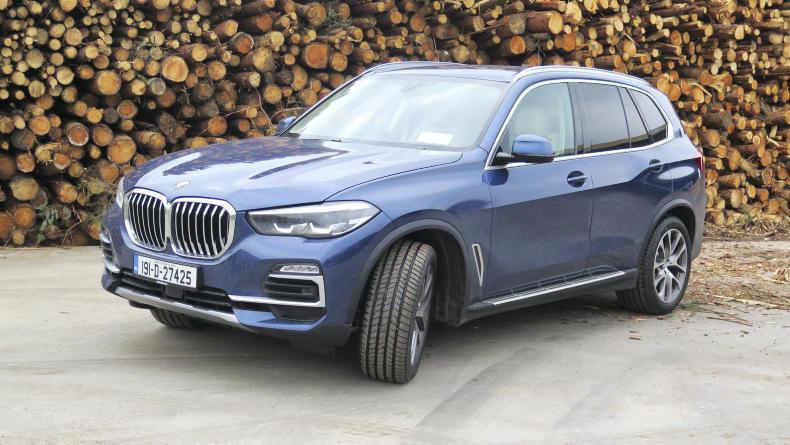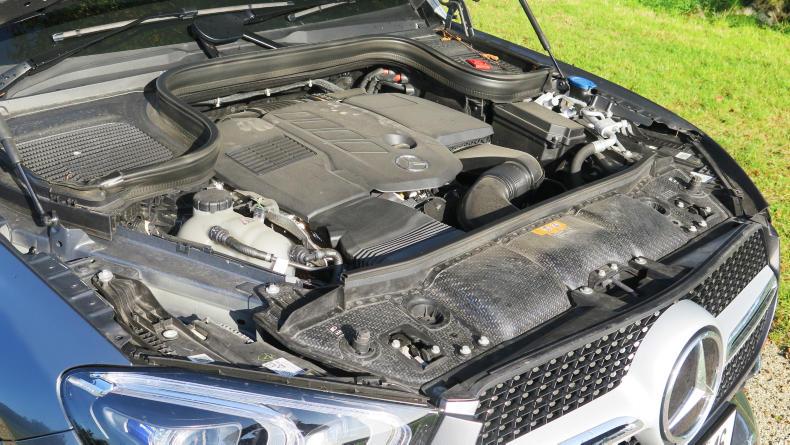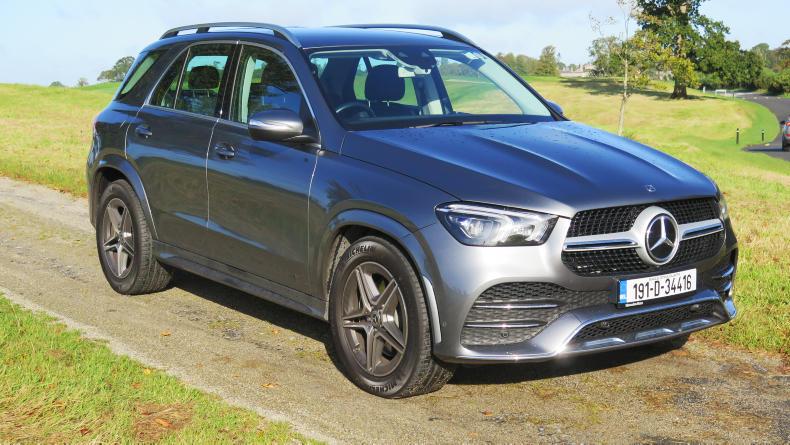Top-end SUVs might seem to be out of the picture for many drivers considering a change in 2020, but life is not always as it seems. Take the two German rivals, the Mercedes-Benz GLE and the BMW X5, both relative newcomers, and you see what’s on offer, especially if you are trading up from another SUV.

The new BMW X5 has powerful performance with new levels of safety specification. Entry prices start from €87,390 or £57,640 in N. Ireland.
If the money gap is bearable, they can offer good towing ability with good economy and genuine road performance. I’ve driven the new Mercedes-Benz GLE in recent weeks. Its predecessor, the M Series, is a popular secondhand choice among farmers. The new model represents a giant step up in terms of comfort while the towing ability remains almost the same.
Some time ago, I had BMW’s new X5 on the road and it too has changed. The engine is still six-cylinder. It is powerful, boosted by twin-turbo technology. So let’s take a closer look at these offers.
For many drivers, the big change will be the extra technology – larger touch-screens and wide dashes that are steeped in new systems. The GLE’s new MBUX infotainment system shows the functions of the engine and speed dials in a single screen that spans across almost two-thirds the dash width.
That feature alone brings it smack up to date. It is now a match for the technology features of the likes of the latest Volkswagen Touareg, another German rival.
This wide screen creates an instant feeling of change inside both the X5 and the GLE compared with the older models, while in some senses they are merely catching up. Indeed, BMW is still catching up in this regard.
Engine
The GLE is powered by a 2.0l diesel while BMW opts for a larger capacity 3.0l six-cylinder unit. The BMW X5 comes out on top in terms of power and torque, while both are a fair match when it comes to towing ability at 2.7t. That puts them well behind the likes of the Range Rover and the Touareg in terms of towing ability.
They are both impressive machines to drive. There is a noticeable grunt from the bigger BMW engine that smoothes out when on the road. The eight-speed automatic gearbox cushions that power and absorbs the 620Nm of engine torque to give relatively low-rev cruising.

Mercedes Benz uses a modest twin-turbo 2.0 litre turbo-diesel engine to deliver 245hp and 500Nm of torque.
The smaller Mercedes-Benz engine is more mannerly and smoothly delivers its power through a nine-speed automatic gearbox that is incredibly impressive. Just consider driving a 2.1t 4x4 at 120km/h on the motorway with the engine barely loaded at just over 1,500rpm.
And that’s what ensures the better Mercedes-Benz economy. The lower torque is not a real barrier to performance as there are mere fractions of seconds between them in terms of acceleration speed.

BMW’s X5 is powered by a six-cylinder turbo-diesel engine that produces 265hp and 620Nm of torque for impressive acceleration.
These are hugely efficient SUVs and that’s part of why you have to pay a higher price. The X5 and the GLE have 85l and 80l tank capacities, respectively, and their range levels are impressive.
Over lengthy runs I had a range of 934km in the X5 and just over 1,000km in the GLE. With modern engines that use AdBlue to minimise emissions, these SUVs deliver a level of clean air driving that’s difficult to argue with.
These will be cars to watch out for in the secondhand market in the near future. Both models have retained their looks well over time, especially the X5 in my opinion. So they can and should have a long life ahead of them among second-generation farming users.
Don’t expect them to be the top trailer pullers, and don’t expect them to be the best performers off-road. But realistically, cars like the X5 and GLE will rarely take on anything more challenging than the muddy fields of the Ploughing Championships car parks. They are exceptional road-going SUVs in terms of comfort, road-holding, economy and safety.
Of the two, which would I have liked to keep? That’s a difficult question. The BMW X5 has a noticeable powerful feeling to it. The Mercedes-Benz is more relaxed in its motion and delivers better economy as a result.

The Mercedes Benz GLE is available with a third row of seats and electric opening rear door.
Price differences are not hugely relevant because, while the entry-level GLE looks competitive, it’s a very short step up to matching the BMW X5 entry price. With SUVs such as these, it’s easy to talk yourself into a price tag of more than €100,000 or £75,000; that’s if you can afford it.
Still don’t ever rule out the opportunity to drive a quality SUV and prepare for some lengthy quality driving years behind the wheel. Both now offer so much in terms of comfort, specification and economy that you’ll never feel the driving time.
And after that, I would probably take the Mercedes-Benz GLE as my first choice for its range of features and relaxed driving.
Top-end SUVs might seem to be out of the picture for many drivers considering a change in 2020, but life is not always as it seems. Take the two German rivals, the Mercedes-Benz GLE and the BMW X5, both relative newcomers, and you see what’s on offer, especially if you are trading up from another SUV.

The new BMW X5 has powerful performance with new levels of safety specification. Entry prices start from €87,390 or £57,640 in N. Ireland.
If the money gap is bearable, they can offer good towing ability with good economy and genuine road performance. I’ve driven the new Mercedes-Benz GLE in recent weeks. Its predecessor, the M Series, is a popular secondhand choice among farmers. The new model represents a giant step up in terms of comfort while the towing ability remains almost the same.
Some time ago, I had BMW’s new X5 on the road and it too has changed. The engine is still six-cylinder. It is powerful, boosted by twin-turbo technology. So let’s take a closer look at these offers.
For many drivers, the big change will be the extra technology – larger touch-screens and wide dashes that are steeped in new systems. The GLE’s new MBUX infotainment system shows the functions of the engine and speed dials in a single screen that spans across almost two-thirds the dash width.
That feature alone brings it smack up to date. It is now a match for the technology features of the likes of the latest Volkswagen Touareg, another German rival.
This wide screen creates an instant feeling of change inside both the X5 and the GLE compared with the older models, while in some senses they are merely catching up. Indeed, BMW is still catching up in this regard.
Engine
The GLE is powered by a 2.0l diesel while BMW opts for a larger capacity 3.0l six-cylinder unit. The BMW X5 comes out on top in terms of power and torque, while both are a fair match when it comes to towing ability at 2.7t. That puts them well behind the likes of the Range Rover and the Touareg in terms of towing ability.
They are both impressive machines to drive. There is a noticeable grunt from the bigger BMW engine that smoothes out when on the road. The eight-speed automatic gearbox cushions that power and absorbs the 620Nm of engine torque to give relatively low-rev cruising.

Mercedes Benz uses a modest twin-turbo 2.0 litre turbo-diesel engine to deliver 245hp and 500Nm of torque.
The smaller Mercedes-Benz engine is more mannerly and smoothly delivers its power through a nine-speed automatic gearbox that is incredibly impressive. Just consider driving a 2.1t 4x4 at 120km/h on the motorway with the engine barely loaded at just over 1,500rpm.
And that’s what ensures the better Mercedes-Benz economy. The lower torque is not a real barrier to performance as there are mere fractions of seconds between them in terms of acceleration speed.

BMW’s X5 is powered by a six-cylinder turbo-diesel engine that produces 265hp and 620Nm of torque for impressive acceleration.
These are hugely efficient SUVs and that’s part of why you have to pay a higher price. The X5 and the GLE have 85l and 80l tank capacities, respectively, and their range levels are impressive.
Over lengthy runs I had a range of 934km in the X5 and just over 1,000km in the GLE. With modern engines that use AdBlue to minimise emissions, these SUVs deliver a level of clean air driving that’s difficult to argue with.
These will be cars to watch out for in the secondhand market in the near future. Both models have retained their looks well over time, especially the X5 in my opinion. So they can and should have a long life ahead of them among second-generation farming users.
Don’t expect them to be the top trailer pullers, and don’t expect them to be the best performers off-road. But realistically, cars like the X5 and GLE will rarely take on anything more challenging than the muddy fields of the Ploughing Championships car parks. They are exceptional road-going SUVs in terms of comfort, road-holding, economy and safety.
Of the two, which would I have liked to keep? That’s a difficult question. The BMW X5 has a noticeable powerful feeling to it. The Mercedes-Benz is more relaxed in its motion and delivers better economy as a result.

The Mercedes Benz GLE is available with a third row of seats and electric opening rear door.
Price differences are not hugely relevant because, while the entry-level GLE looks competitive, it’s a very short step up to matching the BMW X5 entry price. With SUVs such as these, it’s easy to talk yourself into a price tag of more than €100,000 or £75,000; that’s if you can afford it.
Still don’t ever rule out the opportunity to drive a quality SUV and prepare for some lengthy quality driving years behind the wheel. Both now offer so much in terms of comfort, specification and economy that you’ll never feel the driving time.
And after that, I would probably take the Mercedes-Benz GLE as my first choice for its range of features and relaxed driving.










 This is a subscriber-only article
This is a subscriber-only article










SHARING OPTIONS: